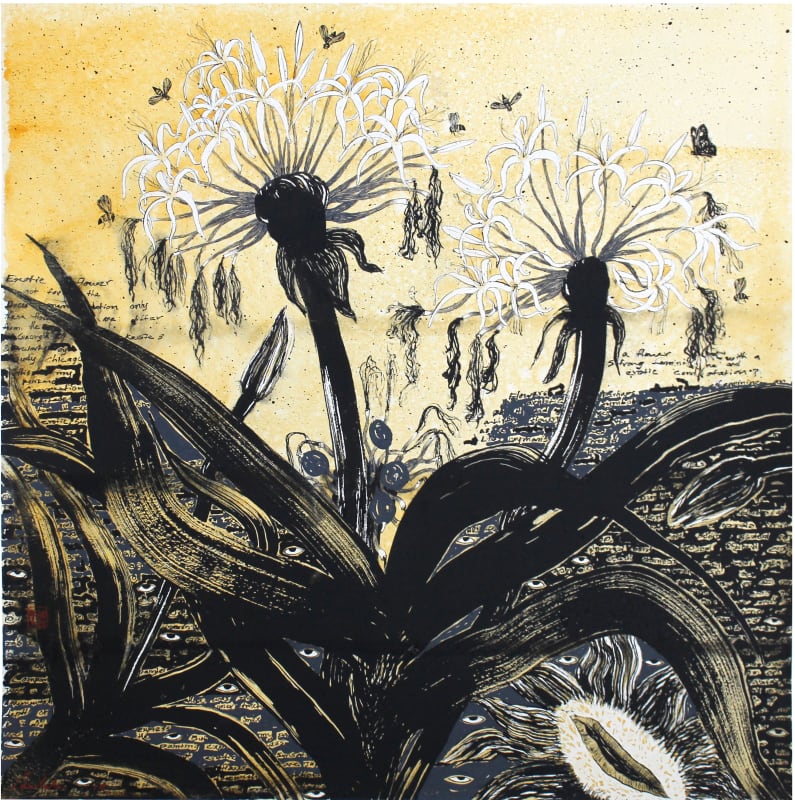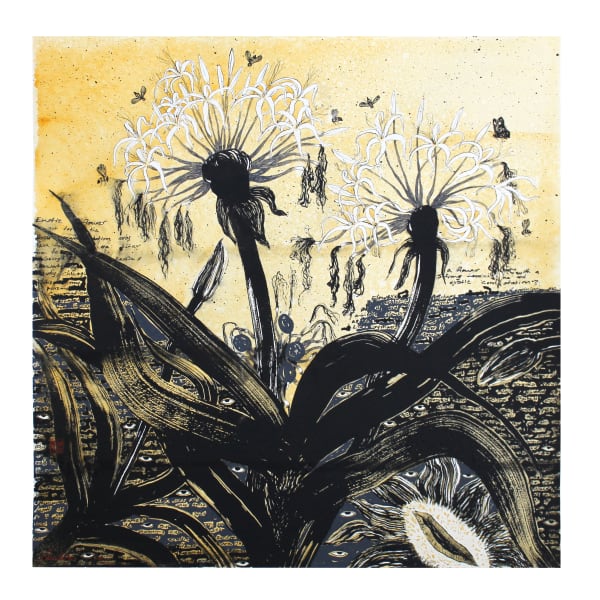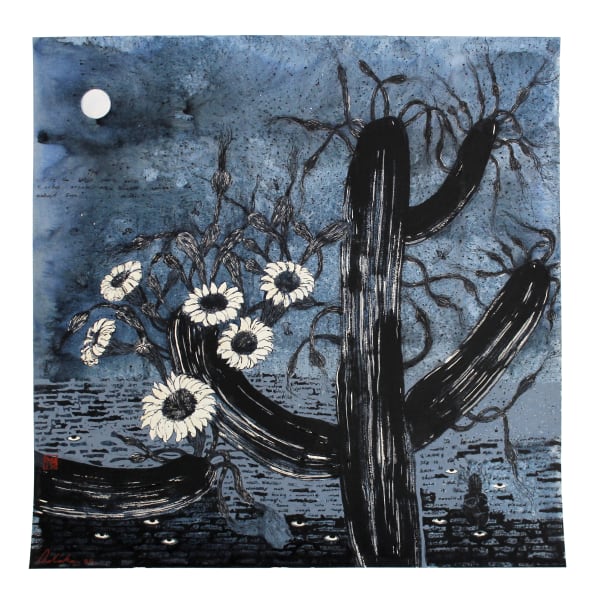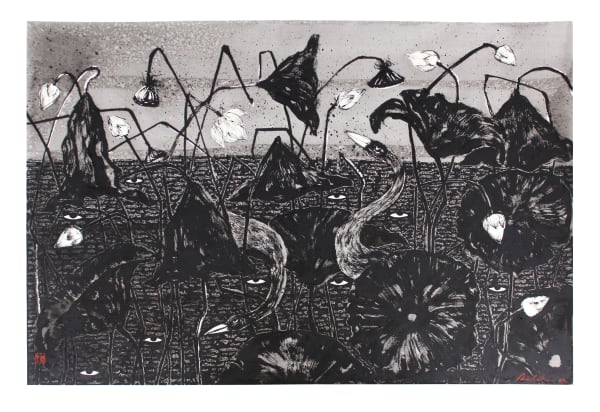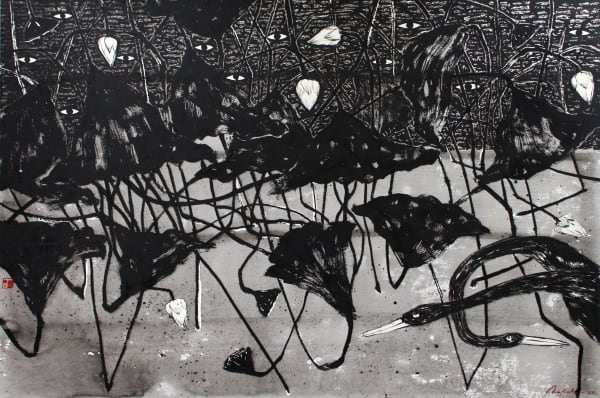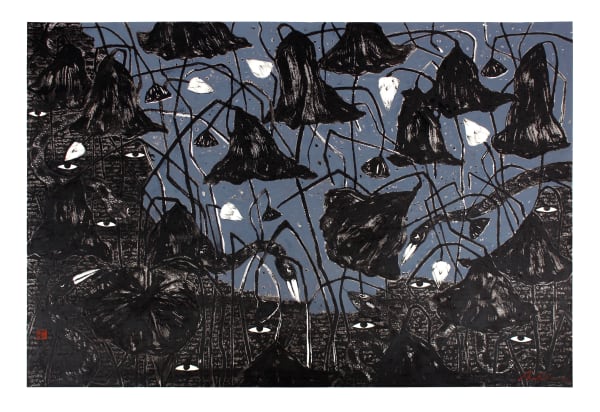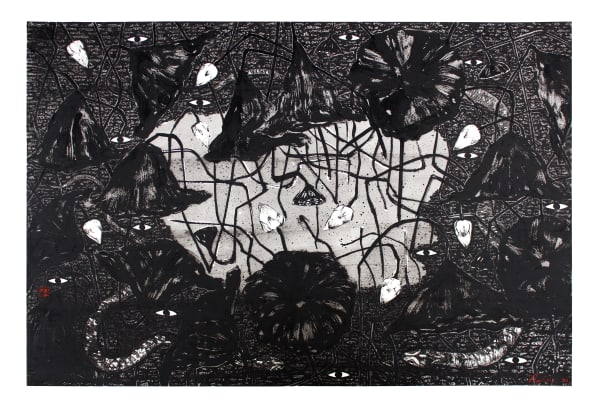Sansāra: Nuwan Nalaka
Nuwan Nalaka fills his latest series of paintings with raw energy produced by the ongoing pandemic. In Sansāra, the artist reflects on the sheer amount of suffering and despair currently endured by so many people around the world. Yet he strives to emphasize the collective strength of humanity that has emerged in this universal experience; the silver linings that will usher the crisis through to its natural end. Nuwan initially planned a different series of work for this showcase, a selection of which are presented in the Cacti series of paintings, but he was so overwhelmed by the immeasurable impact of the pandemic that he felt compelled to make this collection.
Sansāra utilises the symbols explored in Nuwan’s previous showcase Sutra at Saskia Fernando Gallery. Sutra mainly refers to the Lotus Sutra, a quintessential text in the philosophy and religion of Buddhism that was created by Gautama Buddha. Buddhism describes a Middle Path set on the road to Enlightenment that sees as much darkness as it does light. It is on this metaphysical journey that one can understand the balance between the forms of order, chaos, life, death, mind and nature. The motif of the white lotus and the pond from which it emerges is an important symbol in many Buddhist cultures. The pure flower blooms from the murkiest of depths. This represents how mind, body and environment influence each other. In addition to this, the terms nirvana and sansāra are fundamental concepts in Buddhism. Sansāra traditionally refers to the cyclical and often difficult nature of existence, where good and evil are two sides of the same coin; nirvana symbolises the evolution of this cycle and the supreme state of bliss attained when one transcends the material concerns of everyday existence.
Nuwan previously immersed his thoughts within the microcosm of the lotus pond in order to reflect on the relationship between society and spirituality. In Sansāra, he explores these ideas further, but within the context of the global pandemic. The artist presents a stark collection of largely monochromatic paintings, filled with energetic brushstrokes and subtle washes of watercolour paint. There is a relentless focus on the physical nature of his subject matter and the medium of paint. A fearful atmosphere permeates his pictures. However, the impression of emotional turmoil is often held in check with the calm presence of the white lotus flower, both in its open and unopened forms.
An eerie floral template reveals the violent nature of reality and the struggle for survival that lays beneath the surface. The human eyes peering out from behind the plant stems appear indifferent; they signify an ever-present narrative of human population. The open sky seems cold and distant. When reflected in a pool of water it appears as a void even as it provides an opportunity for breathing space. Nuwan develops these contradictions through the presence of fauna that populate the marshlands. Crystalline snakes slither in and out of sight. Black swans appear as a complex blend of beauty, purity and hope as they seem to consume the light and energy around them. The terrifying landscapes suggest the swans’ hybridised role as predatory vultures. White beaks can be fatally mistaken for unopened lotus flowers. Although scavenger-like, the swans retain their symbolic elegance. Despite being a natural part of their frightful surroundings they reveal a sense of presence, playfulness and ease. Nuwan continues to question the placement of humanity within this metaphorical landscape through his vibrant formalism. Sansāra highlights the collective experience of man and nature.
-
 Nuwan Nalaka, Sansāra 01, 2020
Nuwan Nalaka, Sansāra 01, 2020 -
 Nuwan Nalaka, Sansāra 02, 2020
Nuwan Nalaka, Sansāra 02, 2020 -
 Nuwan Nalaka, Sansāra 03 , 2020
Nuwan Nalaka, Sansāra 03 , 2020 -
 Nuwan Nalaka, Sansāra 05, 2020
Nuwan Nalaka, Sansāra 05, 2020
-
 Nuwan Nalaka, Sansāra 06, 2020
Nuwan Nalaka, Sansāra 06, 2020 -
 Nuwan Nalaka, Sansāra 07, 2020
Nuwan Nalaka, Sansāra 07, 2020 -
 Nuwan NalakaSansāra 08, 2020Watercolour on Fabriano Paper75 x 105 cm
Nuwan NalakaSansāra 08, 2020Watercolour on Fabriano Paper75 x 105 cm
29 1/2 x 41 3/8 in -
 Nuwan NalakaSansāra 09, 2020Watercolour on Fabriano Paper75 x 105 cm
Nuwan NalakaSansāra 09, 2020Watercolour on Fabriano Paper75 x 105 cm
29 1/2 x 41 3/8 in
